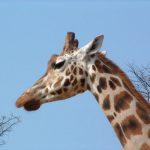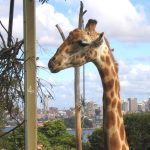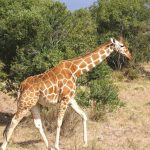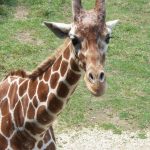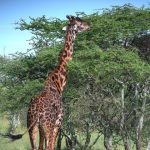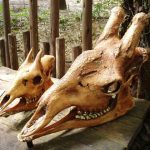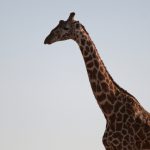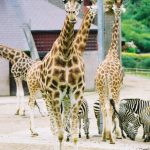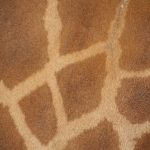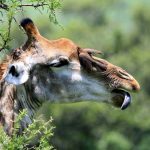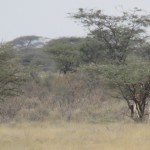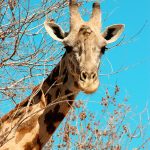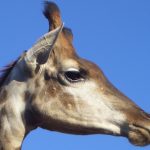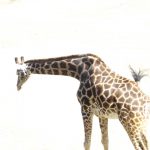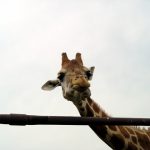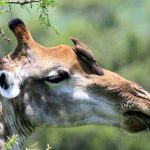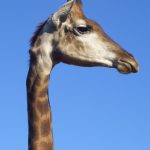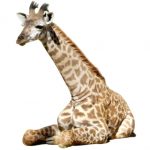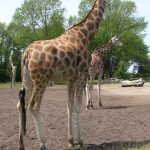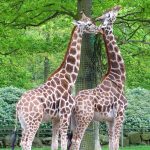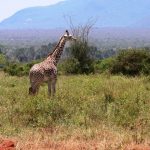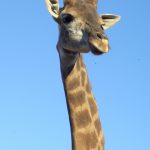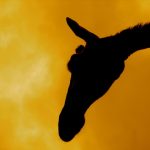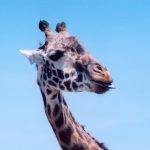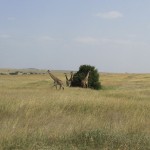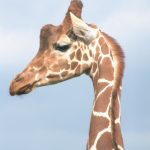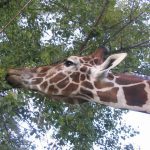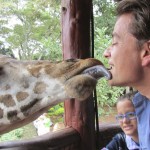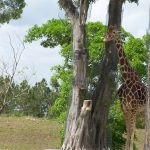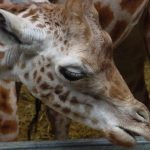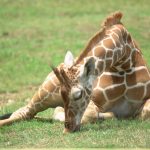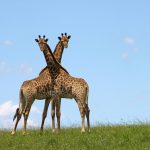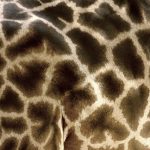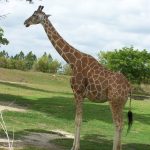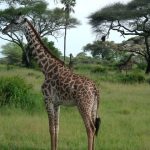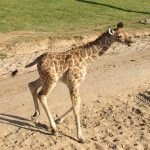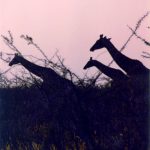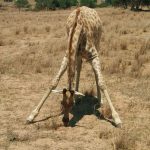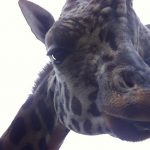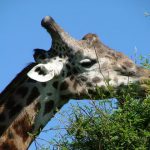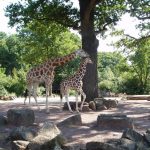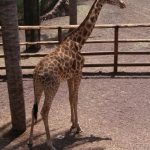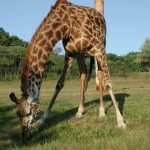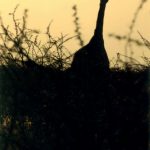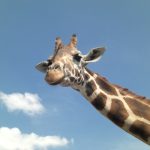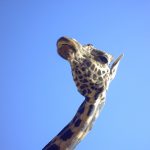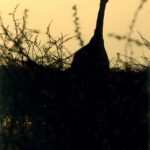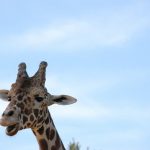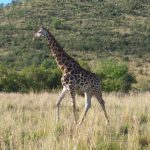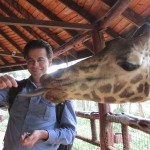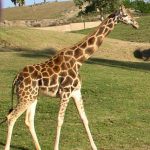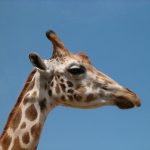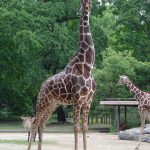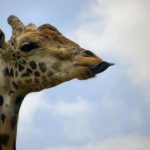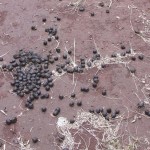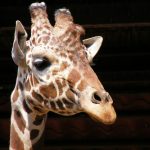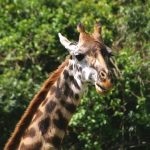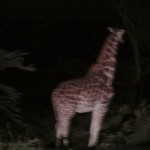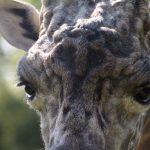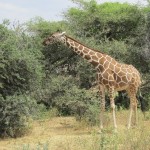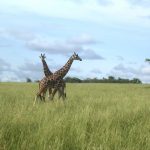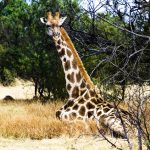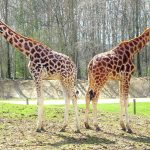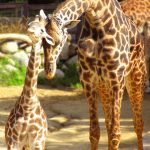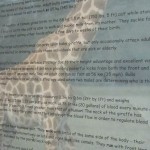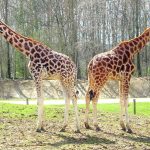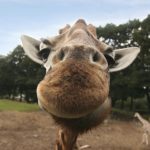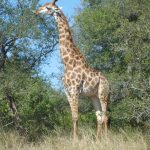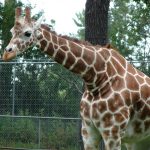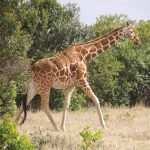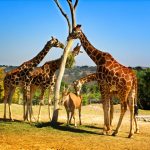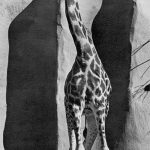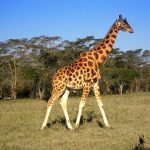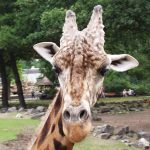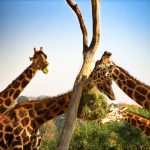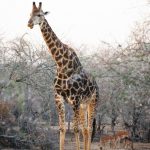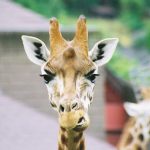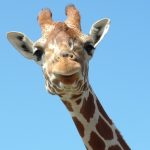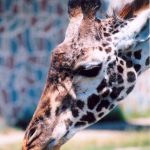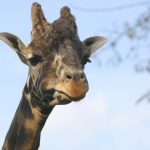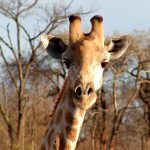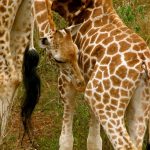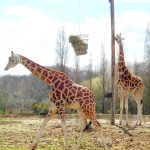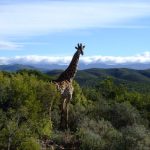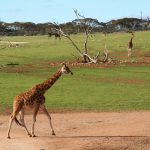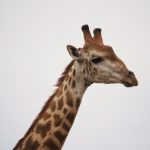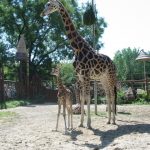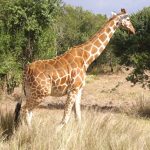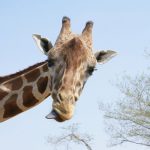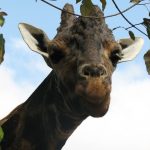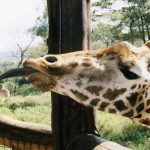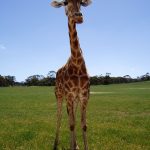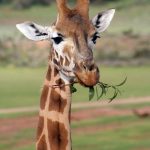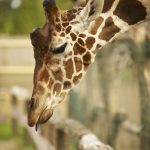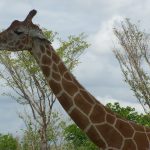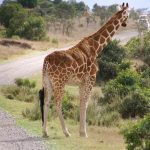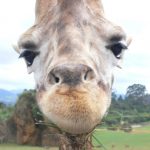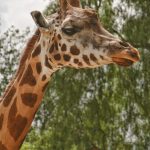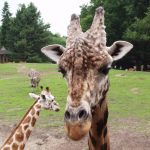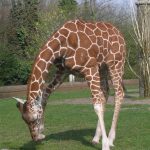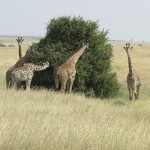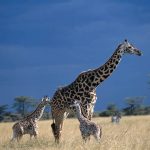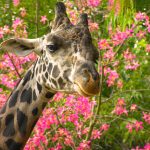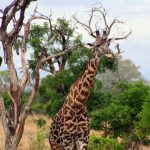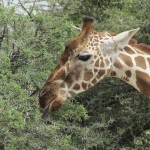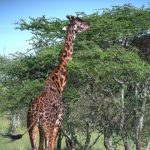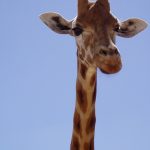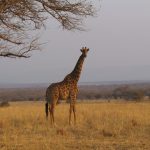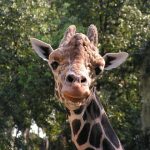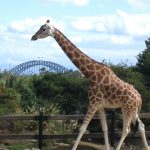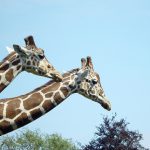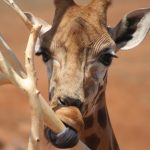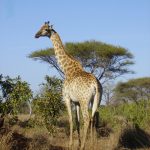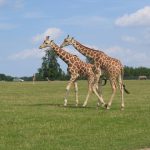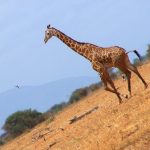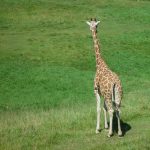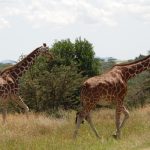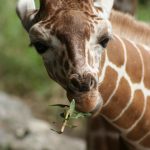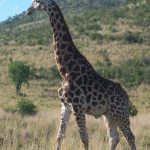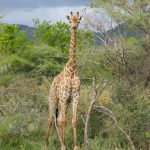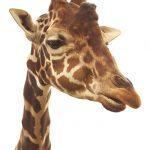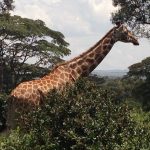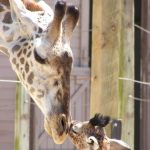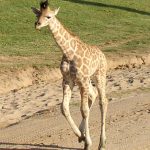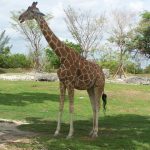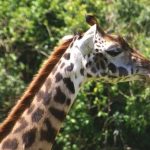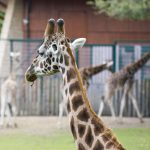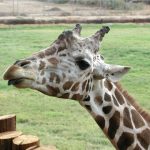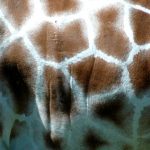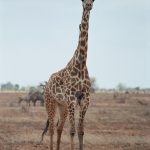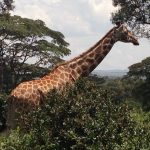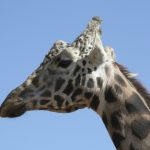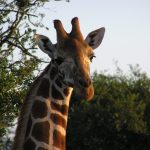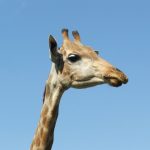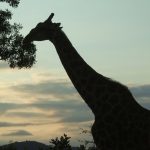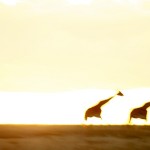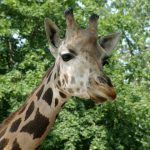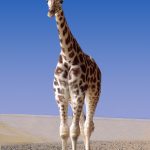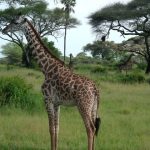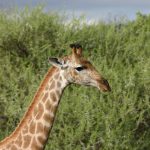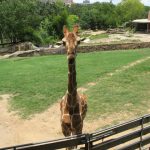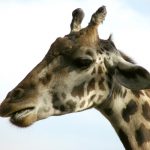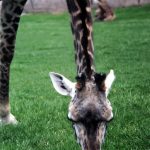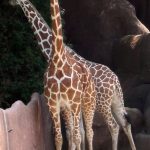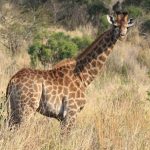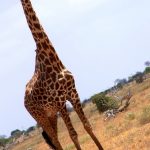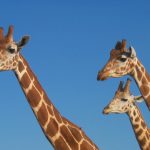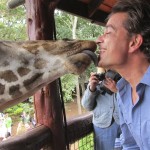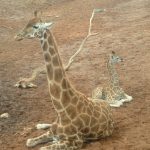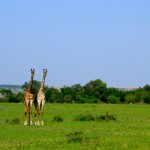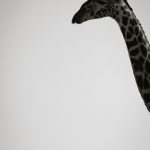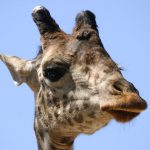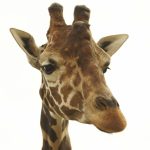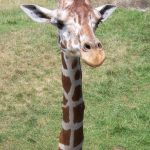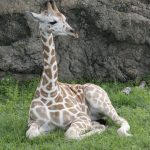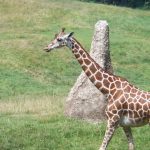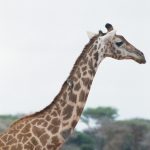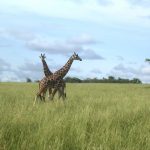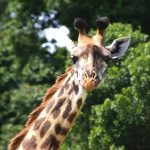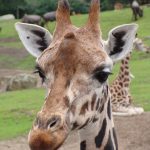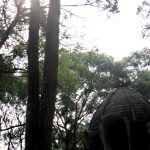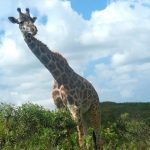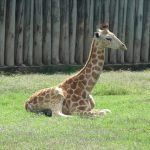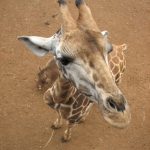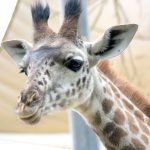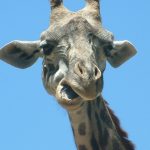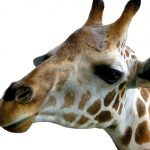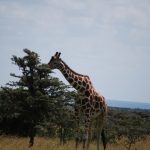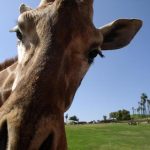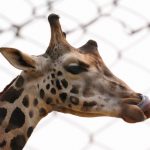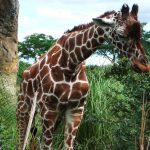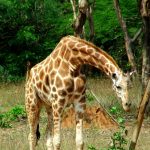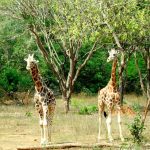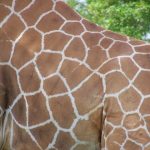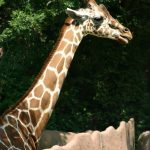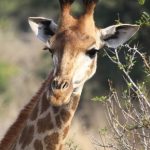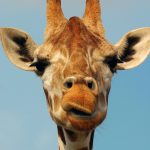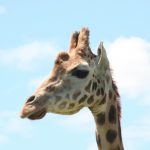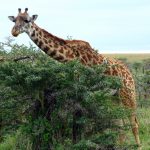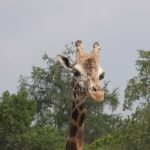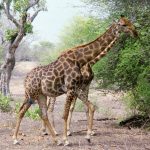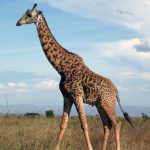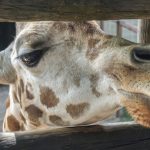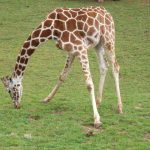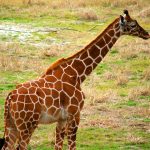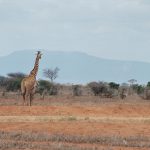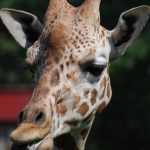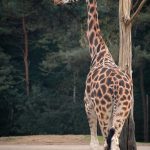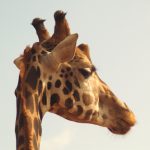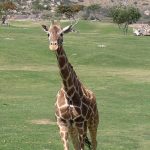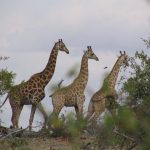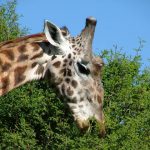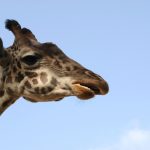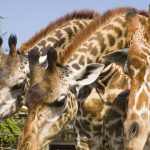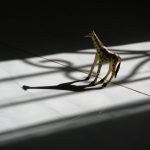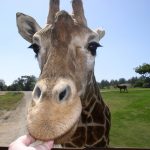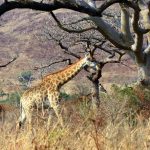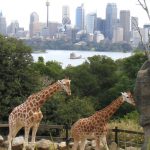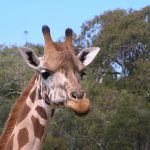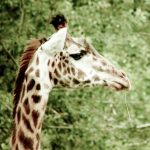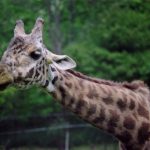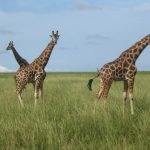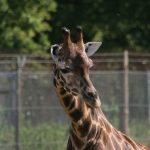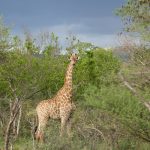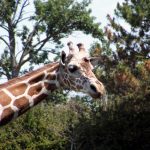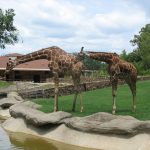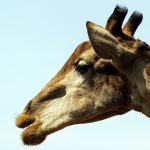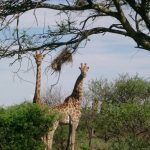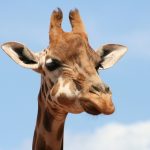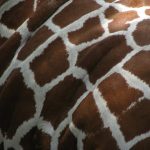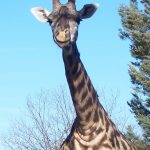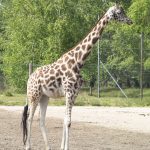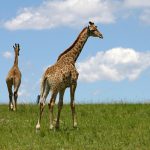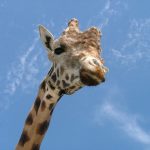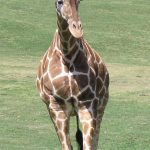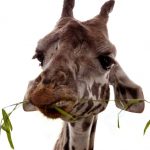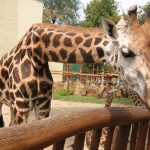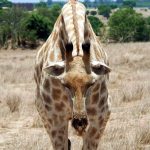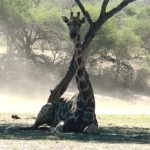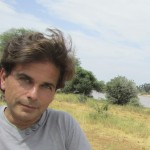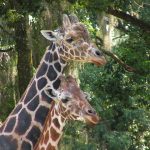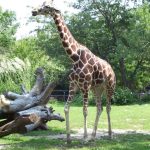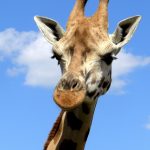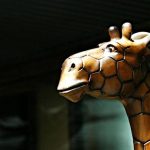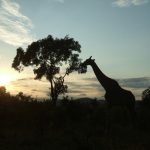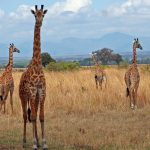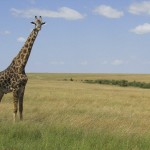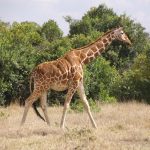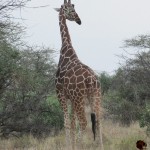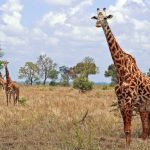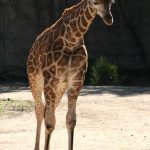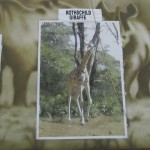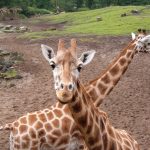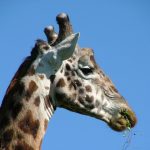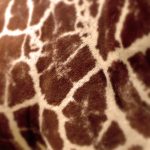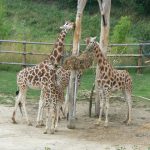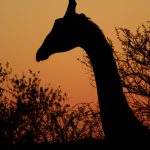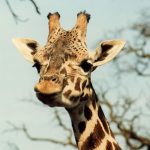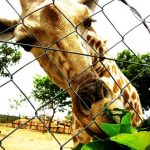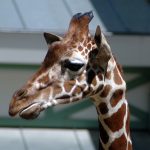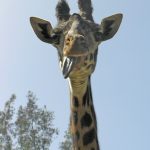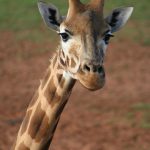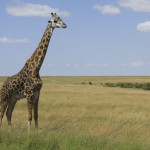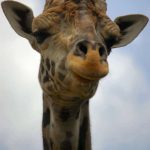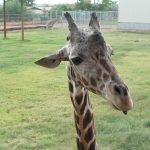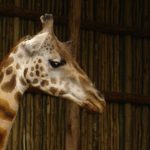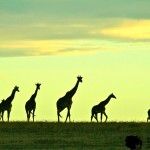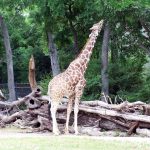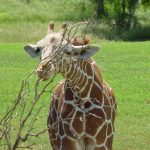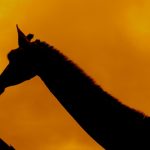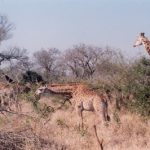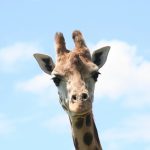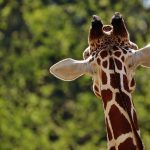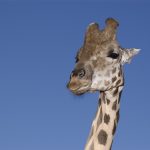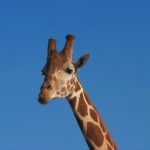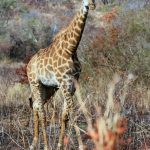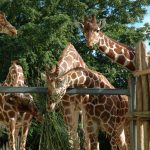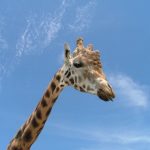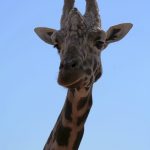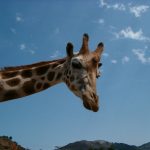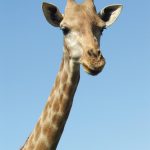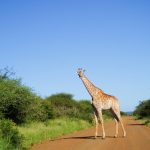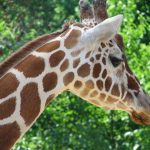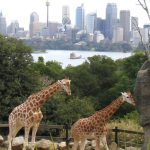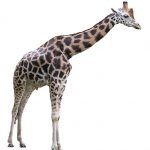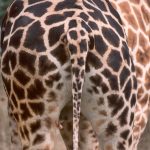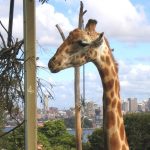- Giraffes are born with their horns that lie flat
- A giraffe’s coat colors vary from practically black to light tan and the differences occur due to what it eats and where it lives
- The reticulated giraffes, only found in Northern Kenya, have dark coats with a web of narrow white lines
- A giraffe is born with its ossicorns that are formed from ossified cartilage
- The reticulated giraffes have dark coats
- The reticulated giraffe, found only in northern Kenya, has a dark coat with a web of narrow white lines while a Masai giraffe has patterns like oak leaves
- Reticulated giraffes have dark coats with a web of narrow white lines
- The Masai giraffe has patterns like oak leaves while the reticulated giraffe has a dark coat with a web of narrow white lines
- A giraffe is born with its horns
- The reticulated giraffe, only found in northern Kenya, has a dark coat with a web of narrow white lines while the Masai giraffe has patterns like oak leaves
- Giraffa camelopardalis is the binomial name of giraffe
- The giraffe is born with its horns but lie flat
- Giraffe coat colors vary from practically black to light tan
- People believed that giraffe was a cross between a camel and a leopard
- Giraffe horns are covered in skin
- Reticulated giraffes have dark coats with a web of narrow white lines while the Masai giraffes, from Kenya, have patterns like oak leaves
- A Masai giraffe has patterns like oak leaves while a reticulated giraffe has a dark coat with a web of narrow white lines
- The giraffe is born with its horns known as ‘ossicorns’ but are not attached to the skull
- Giraffes are characterized by its long neck, long legs, and distinctive spotted pattern
- Characterized by its distinctive pattern, long legs, and long neck, many people first believed that a giraffe was a cross between a camel and a leopard
- The legs of the giraffes are 1.8 meters long
- Giraffes’ coat colors vary from practically black to light tan
- The reticulated giraffe is only found in northern Kenya
- The giraffes are born with their ossicorns but are not attached to the skull
- Giraffes belong to the Giraffa genus
- Giraffe ‘horns’ are not called horns but are called ‘ossicones’
- Giraffe is born with its ossicones
- Giraffes and the okapis have seven cervical vertebrae.
- A reticulated giraffe, only found in northern Kenya, has a dark coat with a web of narrow white lines while a Masai giraffe has patterns like oak leaves
- The back legs of giraffe look shorter than the front legs
- Giraffes are born with their horns known as ‘ossicorns’ but are not attached to the skull
- According to recent study of giraffe genetics concluded that there are four distinct species of giraffes
- The giraffe’s coat colors vary from practically black to light tan and the differences occur due to what it eats and where it lives
- The back legs of the giraffe look shorter than the front legs
- The reticulated giraffe is found only in northern Kenya
- The reticulated giraffes, found only in Northern Kenya, have dark coats
- The giraffes are born with their horns called ‘ossicorns’ but are not attached to the skull
- Giraffe is born with its horns but they lie flat
- Giraffes are born with their horns known as ‘ossicorns’ that are formed from ossified cartilage and covered in skin
- The giraffe is born with its horns but are not attached to the skull
- The legs of the giraffe are 6 feet but the back legs look shorter than the front legs
- The giraffe has a small hump
- Giraffe is born with its ossicorns that are formed from ossified cartilage
- The giraffe is the tallest land animal
- Recent study of giraffe genetics concluded that there are four distinct species of giraffes
- The giraffe is born with its horns but they kind of lie flat
- Giraffe’s coat colors vary from practically black to light tan and the differences occur due to what it eats and where it lives
- A reticulated giraffe has a dark coat with a web of narrow white lines while a Masai giraffe, from Kenya, has patterns like oak leaves
- A Masai giraffe has markings that look like oak leaves and are as individual as our fingerprints
- The binomial name of giraffe is Giraffa camelopardalis
- A giraffe is born with its horns that are formed from ossified cartilage
- Both female and male giraffes have horns but are not called but ‘ossicones’ that are formed from ossified cartilage and covered in skin
- A reticulated giraffe, found only in northern Kenya, has a dark coat with a web of narrow white lines while a Masai giraffe, from Kenya, has patterns like oak leaves
- The giraffe is born with its ossicorns but are not attached to the skull
- Generally, only dominant males mate.
- Giraffes are born with their horns called ‘ossicones’
- The reticulated giraffe has a dark coat
- Giraffes belong to the Giraffidae family
- Reticulated giraffes have dark coats with a web of narrow white lines while Masai giraffes, from Kenya, have patterns like oak leaves
- Giraffe’s lips, palate and tongue are tough enough to even deal with sharp thorns in trees
- Giraffe is born with its horns that are formed from ossified cartilage
- The reticulated giraffe, found only in northern Kenya, has a dark coat with a web of narrow white lines while the Masai giraffe, from Kenya, has patterns like oak leaves
- The giraffe is born with its horns that are formed from ossified cartilage
- Many people first believed that giraffes were a cross between a camel and a leopard
- Giraffe is a large African mammal with a long neck and forelegs
- Reticulated giraffe has a dark coat with a web of narrow white lines while Masai giraffe has patterns like oak leaves
- A giraffe is born with its horns but are not attached to the skull
- The reticulated giraffe has a dark coat with a web of narrow white lines while a Masai giraffe, from Kenya, has patterns like oak leaves
- A recent study of giraffe genetics concluded that there are four distinct species of giraffes
- Reticulated giraffes, found only in Northern Kenya, have dark coats with a web of narrow white lines
- Masai giraffe has patterns like oak leaves while reticulated giraffe has a dark coat with a web of narrow white lines
- The back legs of a giraffe look shorter than the front legs
- The giraffes’ coat colors vary from practically black to light tan and the differences occur due to what they eat and where they live
- The giraffe is born with its ossicones
- The differences of the giraffe’s coat colors occur due to what they eat and where they live
- The reticulated giraffe has a dark coat with a web of narrow white lines while Masai giraffe, from Kenya, has patterns like oak leaves
- Both female and male giraffe have horns and are formed from ossified cartilage
- Many people believed that giraffes were a cross between a camel and a leopard
- Giraffes’ closest relatives are the okapis
- A giraffe is born with its ossicones
- Characterized by its distinctive pattern, long neck, and long legs, many people first believed that giraffes were a cross between a camel and a leopard
- Reticulated giraffe is found only in northern Kenya
- Many people first believed that giraffe was a cross between a camel and a leopard
- The giraffe is born with its horns called ‘ossicorns’ but are not attached to the skull
- Giraffe’s coat colors vary from practically black to light tan
- Characterized by its distinctive pattern, long neck, and long legs, many people first believed that a giraffe was a cross between a camel and a leopard
- A giraffe is born with its horns that lie flat
- The reticulated giraffes, found only in Northern Kenya, have dark coats with a web of narrow white lines
- Giraffe ‘horns’ are not called horns but ‘ossicones’
- Giraffes’ markings are as unique as our fingerprints
- Giraffes are characterized by its long neck, long legs, and distinctive spotted pattern
- Giraffe horns are called ‘ossicones’ and are formed from ossified cartilage
- A reticulated giraffe has a dark coat with a web of narrow white lines while the Masai giraffe has patterns like oak leaves
- The Masai giraffe has markings that look like oak leaves and are is as individual as our fingerprints
- A giraffe’s markings are as unique as our fingerprints
- Masai giraffe has markings that look like oak leaves
- Characterized by its distinctive pattern, long legs, and long neck, many people believed that a giraffe was a cross between a camel and a leopard
- The legs of giraffes are 1.8 meters long
- Giraffes are born with their horns but they lie flat
- The reticulated giraffes are found only in northern Kenya
- Giraffes belong to the G. Camelopardalis species
- Both female and male giraffes have horns
- The giraffes’ markings are as unique as our fingerprints
- Researchers believe that reticulated giraffes are genetically different from the other subspecies
- Giraffe is the tallest living animal
- The legs of giraffes are 6 feet but the back legs look shorter than the front legs
- The giraffe is born with its horns that lie flat
- A giraffe has a small hump on its back
- A reticulated giraffe, found only in northern Kenya, has a dark coat with a web of narrow white lines while the Masai giraffe has patterns like oak leaves
- A giraffe is born with its horns called ‘ossicones’
- Giraffe is characterized by its long neck, long legs, and distinctive spotted pattern
- A giraffe is born with its ossicorns but are not attached to the skull
- The giraffe’s coat colors vary from practically black to light tan
- The scientific name of the giraffe is Giraffa camelopardalis because of the belief that a giraffe was a cross between a camel and a leopard
- Reticulated giraffe, found only in northern Kenya, has a dark coat with a web of narrow white lines while a Masai giraffe, from Kenya, has patterns like oak leaves
- Giraffe is born with its horns that lie flat
- The legs of giraffe are 1.8 meters long
- The giraffe is born with its horns known as ‘ossicorns’ that are formed from ossified cartilage and covered in skin
- A Masai giraffe has markings that look like oak leaves
- The are four distinct species of giraffes
- The Masai giraffes have patterns like oak leaves while the reticulated giraffes have dark coats with a web of narrow white lines
- Reticulated giraffes are found only in northern Kenya
- The reticulated giraffe has a dark coat with a web of narrow white lines while Masai giraffe has patterns like oak leaves
- The giraffes are born with their horns known as ‘ossicorns’ but are not attached to the skull
- The reticulated giraffes have dark coats with a web of narrow white lines while Masai giraffes, from Kenya, have patterns like oak leaves
- Masai giraffe has markings that look like oak leaves and are as individual as our fingerprints
- Reticulated giraffes, only found in northern Kenya, have dark coats with a web of narrow white lines while the Masai giraffes have patterns like oak leaves
- The giraffe is born with its ossicorns that are formed from ossified cartilage
- A reticulated giraffe has a dark coat
- Reticulated giraffes are only found in northern Kenya
- The giraffes’ closest relatives are the okapis
- The giraffe is born with its horns
- A giraffe’s coat colors vary from practically black to light tan and the differences occur due to what they eat and where they live
- A giraffe is born with its horns called ‘ossicorns’ but are not attached to the skull
- Rete mirabile prevents the excess blood flow to the brain of the giraffe when the neck is lowered
- The reticulated giraffes are only found in northern Kenya
- Despite the vast difference in the length of the neck the giraffe and okapi have seven cervical vertebrae.
- The giraffes are born with their horns but are not attached to the skull
- Giraffe is born with its horns known as ‘ossicorns’ but are not attached to the skull
- The legs of a giraffe are 1.8 meters long
- Giraffe has a small hump on its back
- The giraffe’s scientific name is Giraffa camelopardalis
- Giraffes live mainly in savanna areas
- The reticulated giraffes, only found in northern Kenya, have dark coats with a web of narrow white lines while the Masai giraffes have patterns like oak leaves
- The differences of giraffes’ coat colors occur due to what they eat and where they live
- Characterized by its distinctive pattern, long legs, and long neck, many people first believed that giraffes were a cross between a camel and a leopard
- Masai giraffes have patterns like oak leaves while the reticulated giraffes have dark coats with a web of narrow white lines
- Giraffe is born with its horns
- Both female and male giraffes have horns called ‘ossicones’ and are formed from ossified cartilage
- Giraffes and the okapis both have seven cervical vertebrae.
- Giraffe lives in savanna areas
- The giraffe and the okapi both have seven cervical vertebrae.
- Researchers believe that reticulated giraffes are genetically different from the other subspecies to be reclassified as a separate species
- The giraffe is born with its horns but they lie flat
- Masai giraffes have markings that look like oak leaves
- Many people first believed that giraffe was a cross between a camel and a leopard
- The reticulated giraffes have dark coats with a web of narrow white lines
- A giraffe is born with its horns but they lie flat
- Reticulated giraffe has a dark coat with a web of narrow white lines while Masai giraffe, from Kenya, has patterns like oak leaves
- Reticulated giraffe has a dark coat with a web of narrow white lines while the Masai giraffe has patterns like oak leaves
- The Masai giraffe has markings that look like oak leaves and are as individual as our fingerprints
- Masai giraffes have markings that look like oak leaves and are as individual as our fingerprints
- The giraffe’s coat colors vary from practically black to light tan and the differences occur due to what they eat and where they live
- A giraffe’s scientific name is Giraffa camelopardalis
- Giraffe horns are not called horns but ‘ossicones’ that are covered in skin
- The reticulated giraffes, only found in Northern Kenya, have dark coats
- The reticulated giraffe has a dark coat with a web of narrow white lines while the Masai giraffe has patterns like oak leaves
- Giraffes are born with their ossicorns that are formed from ossified cartilage
- The Masai giraffes have markings that look like oak leaves and are as individual as our fingerprints
- The reticulated giraffe are found only in northern Kenya
- A giraffe is the tallest land animal
- The giraffe’s closest relative is the okapi
- Giraffe legs and neck are 6 feet long each
- A reticulated giraffe, found only in northern Kenya, has a dark coat with a web of narrow white lines while Masai giraffe, from Kenya, has patterns like oak leaves
- A reticulated giraffe, only found in northern Kenya, has a dark coat with a web of narrow white lines while the Masai giraffe has patterns like oak leaves
- Giraffe’s markings are as unique as our fingerprints
- Giraffes are born with their horns that are formed from ossified cartilage
- Reticulated giraffes, only found in Northern Kenya, have dark coats
- The Masai giraffes have patterns like oak leaves while reticulated giraffes have dark coats with a web of narrow white lines
- The giraffe is characterized by its long neck, long legs, and distinctive spotted pattern
- The legs of the giraffe are 1.8 meters long
- Giraffe’s closest relative is the okapi
- Characterized by its distinctive pattern, long neck, and long legs, many people believed that a giraffe was a cross between a camel and a leopard
- The legs of a giraffe are 6 feet but the back legs look shorter than the front legs
- Reticulated giraffe has a dark coat
- A Masai giraffe has markings that look like oak leaves and are is as individual as our fingerprints
- Giraffe has a small hump
- Giraffes are born with their horns called ‘ossicorns’ but are not attached to the skull
- The giraffe is born with its horns called ‘ossicones’
- A reticulated giraffe, found only in northern Kenya, has a dark coat with a web of narrow white lines while a Masai giraffe has patterns like oak leaves
- A reticulated giraffe has a dark coat with a web of narrow white lines while a Masai giraffe has patterns like oak leaves
- A reticulated giraffe has a dark coat with a web of narrow white lines while the Masai giraffe, from Kenya, has patterns like oak leaves
- Giraffe’s scientific name is Giraffa camelopardalis because of the belief that giraffes were a cross between a camel and a leopard
- According to a recent study of giraffe genetics there are four distinct species of giraffes
- Giraffe horns are formed from ossified cartilage
- Researchers believe that reticulated giraffes are genetically different enough to be reclassified as a separate species
- Giraffes are born with their ossicones
- Reticulated giraffe has a dark coat with a web of narrow white lines while the Masai giraffe, from Kenya, has patterns like oak leaves
- A reticulated giraffe is found only in northern Kenya
- Giraffe is the tallest land animal
- A giraffe’s closest relative is the okapi
- The reticulated giraffe, only found in northern Kenya, has a dark coat with a web of narrow white lines while a Masai giraffe has patterns like oak leaves
- A reticulated giraffe is only found in northern Kenya
- The legs of the giraffes are 6 feet but the back legs look shorter than the front legs
- The giraffes are the tallest land animals
- The giraffe has a small hump on its back
- Giraffes’ coat colors vary from practically black to light tan and the differences occur due to what they eat and where they live
- Giraffe is born with its horns but lie flat
- The differences of a giraffe’s coat colors occur due to what they eat and where they live
- Giraffe legs are 6 feet long
- Giraffes are born with their horns
- The reticulated giraffe has a dark coat with a web of narrow white lines while the Masai giraffe, from Kenya, has patterns like oak leaves
- The legs of giraffe are 6 feet but the back legs look shorter than the front legs
- Giraffes have a small hump
- A giraffe has a small hump
- The back legs of the giraffes look shorter than the front legs
- The reticulated giraffes, only found in northern Kenya, have dark coats with a web of narrow white lines while Masai giraffes have patterns like oak leaves
- Reticulated giraffes, found only in Northern Kenya, have dark coats
- Both female and male giraffes have horns and are not called horns but ‘ossicones’
- A giraffe is characterized by its long neck, long legs, and distinctive spotted pattern
- People believed that giraffes were a cross between a camel and a leopard
- Giraffes belong to the Chordata phylum
- The scientific name of the giraffe is Giraffa camelopardalis because of the belief that giraffes were a cross between a camel and a leopard
- The reticulated giraffe, found only in northern Kenya, has a dark coat with a web of narrow white lines while the Masai giraffe has patterns like oak leaves
- Many people first believed that a giraffe was a cross between a camel and a leopard
- Reticulated giraffes have dark coats
- The scientific name of the giraffe is Giraffa camelopardalis
- Giraffe is born with its horns called ‘ossicones’
- The reticulated giraffe, found only in northern Kenya, has a dark coat with a web of narrow white lines while a Masai giraffe, from Kenya, has patterns like oak leaves
- Giraffes belong to the Artiodactyla order
- The Masai giraffe has markings that look like oak leaves
- Giraffes belong to the Animalia kingdom
- Reticulated giraffe, found only in northern Kenya, has a dark coat with a web of narrow white lines while Masai giraffe, from Kenya, has patterns like oak leaves
- Giraffe lives primarily in savanna areas
- Giraffe skin is patterned with brown patches separated by white lines
- Giraffe’s scientific name is Giraffa camelopardalis
- Giraffes are born with their horns but are not attached to the skull
- Giraffe’s coat colors vary from practically black to light tan and the differences occur due to what they eat and where they live
- A giraffe is born with its horns known as ‘ossicorns’ that are formed from ossified cartilage and covered in skin
- Both female and male giraffes have horns that are called ‘ossicones covered in skin
- Giraffe are born with their ossicones
- Giraffes are the tallest land animals
- The reticulated giraffes have dark coats with a web of narrow white lines while the Masai giraffes, from Kenya, have patterns like oak leaves
- The scientific name of a giraffe is Giraffa camelopardalis
- A giraffe’s coat colors vary from practically black to light tan
- Giraffes belong to the Mammalia Class
- Giraffes are born with their ossicorns but are not attached to the skull
- People believed that the giraffe was a cross between a camel and a leopard
- Giraffe lives mainly in savanna areas
- The giraffe and okapi have seven cervical vertebrae.
- Giraffe coat colors vary from practically black to light tan and the differences occur due to what they eat and where they live
- The giraffe’s markings are as unique as our fingerprints
- Reticulated giraffe is only found in northern Kenya
- The differences of giraffe’s coat colors occur due to what they eat and where they live
- Many people believed that giraffe was a cross between a camel and a leopard
- Researchers now believe that reticulated giraffes are genetically different enough to be reclassified as a separate species
- The Masai giraffes have markings that look like oak leaves
- Both female and male giraffe have horns called ‘ossicones’ and are formed from ossified cartilage
- Reticulated giraffes, only found in Northern Kenya, have dark coats with a web of narrow white lines
- Giraffes are born with their horns but lie flat
- The back legs of giraffes look shorter than the front legs
- Both female and male giraffes have horns that are covered in skin
- Giraffe is born with its horns known as ‘ossicorns’ that are formed from ossified cartilage and covered in skin
- A giraffe is born with its horns known as ‘ossicorns’ but are not attached to the skull
- The reticulated giraffe, found only in northern Kenya, has a dark coat with a web of narrow white lines while Masai giraffe, from Kenya, has patterns like oak leaves
- Masai giraffe has markings that look like oak leaves and are is as individual as our fingerprints
- The reticulated giraffe has a dark coat with a web of narrow white lines while a Masai giraffe has patterns like oak leaves
- The differences of the giraffes’ coat colors occur due to what they eat and where they live
- A giraffe is born with its horns but lie flat
- Giraffe neck and legs are 6 feet long each
5 facts about giraffe
- The giraffe is an even-toed ungulate mammal
- Giraffe is the tallest living terrestrial animal
- A giraffe is the largest ruminant
- The world’s tallest mammals are giraffes
- Giraffe’s legs are taller than many humans
To receive a colourful digibook about giraffe with videos, images and text, please fill out the following form or simply email us on safaris@safari-center.com

